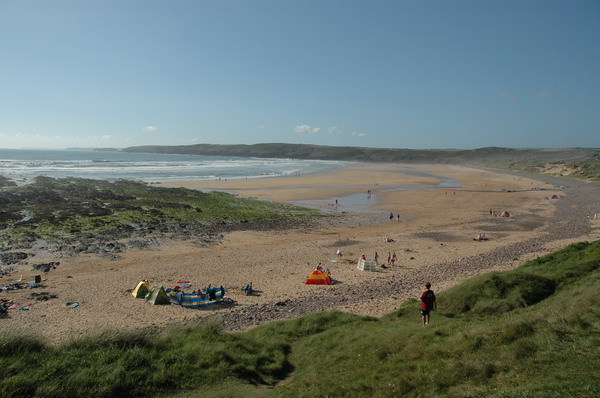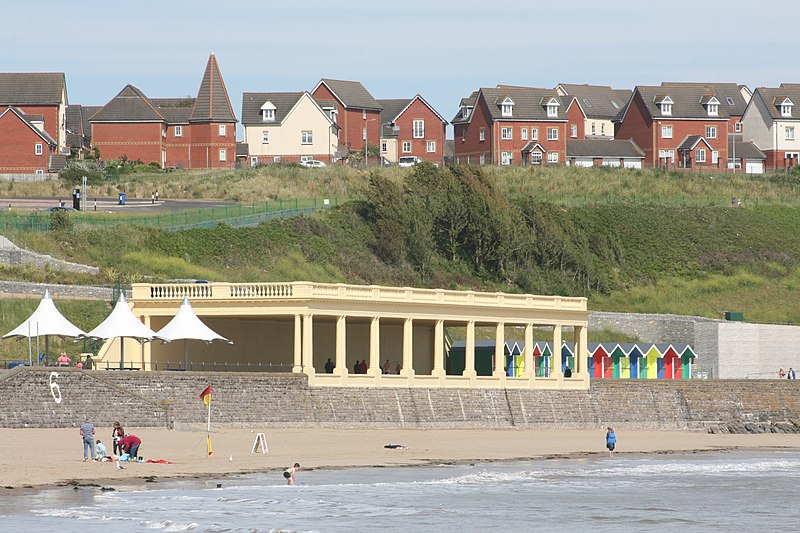Summer’s here and it’s time to head for the beach, but in
between leaping into the waves and sunning yourself, why not stop to consider
all the wonderful film and TV scenes produced over the years featuring the
nation’s stunning beaches. Here is a
baker’s dozen of British beaches which have featured on the big and small
screen.
Holywell Beach,
Cornwall
In the third series of Poldark Geoffrey Charles, stepson of
George Warleggan, is seen visiting a beautiful beach and declaring it the best
beach in Cornwall. In another episode
the same beach forms the backdrop for the romantic reunion of Geoffrey Charles’
governess Morwenna and Demelza’s brother Drake.
The beach in question is the one at Holywell Bay, easily recognisable
from the two pointy islets just offshore known as Gull Rocks. This is not the first time the beach has been
seen on screen: it appears on the big screen in Summer In February, the 2013
film about an Edwardian artists’ colony in Cornwall, in which Gilbert Evans and
Alfred Munnings are seen riding together on horseback and discussing the love
interest, the fragrant Florence Carter-Wood.
The bay’s name derives from St Cubert’s Holy Well, which is to be found
in Holywell Cave, accessible at low tide.
The cave features in one of the above-mentioned Poldark episodes, when Drake
leads Geoffrey Charles and Morwenna to it.
On a much grimmer note, in 2002 the beach was transformed
into a North Korean battlefield for the opening scenes of the James Bond film Die Another Day, although
apart from a brief glimpse of Gull Rocks you would never recognise it. The lifeguard hut was turned into a pill box
and barbed wire was arranged all over in order to achieve the desired effect.
West Bay, Dorset
The distinctive orange-hued cliffs backing the beach at West
Bay will be forever remembered by Broadchurch fans as the place where the
Latimers’ son Danny was found dead on the beach, a tragic event which formed
the central focus of the first series and continued to weave its way through
the two subsequent series. The beach is
repeatedly seen thereafter, often with dramatic waves crashing onto the
shore. The rocks forming the cliffs date
from the Early Jurassic age and consist of Bridport Sand Formation and Inferior
Oolite. There are also frequent
glimpses of the harbour adjacent to the beach in the series.
Brighton, East Sussex
Brighton Beach has featured in many productions over the
years.
Among the most memorable scenes
is the one in Quadrophenia in which the central character Jimmy is sitting on
the shingle after an eventful night out gazing pensively out to sea,
accompanied by the strains of
The Who’s
‘Love, Reign O’er Me’.
Then there is the
scene from Mona Lisa, in which Bob Hoskins and Cathy Tyson are seen larking
about in comedy sunglasses on the
Palace Pier.
The beach and seafront also appeared in The Boat That Rocked about a
1960s pirate radio station, and of course both the 1947 and 2010 version
of
Brighton Rock, based on the Graham
Greene novel of the same name, featured the seafront, in particular the
pier.
This is just a small selection of
appearances by the film makers’ favourite resort.
Camber Sands, East Sussex
Camber Sands near Rye is a riot of dunes, a rarity in the
south-east. The makers of the Carry On
film Follow That Camel evidently thought the beach resembled the Sahara Desert,
only without the attendant heat and lack of infrastructure. The sands were also seen in a beach scene in
The Theory of Everything, about the life of Stephen Hawking. But most of the appearances by the sands have
been in war films. The 1958 version of
Dunkirk used the beach as the backdrop for a recreation of Operation Dynamo,
and in the 1962 film The Longest Day it was used to depict the Normandy beaches,
a role repeated in the more recent film The Monuments Men, starring George
Clooney and Matt Damon, about an attempt to save art treasures from the Nazis.
Holkham Beach,
Norfolk
This sweeping mass of sand manages to upstage Gwyneth
Paltrow in the final scene in Shakespeare in Love. The actress is seen striding along the beach,
meant to be Shakespeare’s Illyria, in a flowing gown while Joseph Fiennes as
Shakespeare sings her praises in a voiceover.
More recently, the beach became “Area X” in a sci-fi film called
Annihilation starring Natalie Portman. Visitors
to the beach will no doubt want to look in on the nearby Palladian masterpiece
Holkham Hall, which has also been used a fair bit in filming.
Redcar, North
Yorkshire
Like Camber Sands, Redcar’s beach has been used to depict
the beach at Dunkirk, this time in the film version of Ian McEwan’s novel
Atonement, starring Keira Knightley and James McAvoy. The harrowing wartime scenes filmed at Redcar
included local people who were brought in as extras to play the soldiers. One of the excited inhabitants of the town
commented that they wished they could put a price on what the film was worth to
the town, quite justifiably, since visitor numbers jumped by some 70% during
the filming.
Bamburgh,
Northumberland
As well as being a stunning beach, Bamburgh has the added
attraction of being overlooked by one of the country’s most impressive
castles.
This has inevitably made it
irresistible to film makers.
The castle
and beach were used for the filming of the 1971 version of Macbeth, directed by
Roman Polanski, and during the production of the 2015 version the cast and 200
extras were seen at the castle.
The
castle also made an appearance in the 1998 film Elizabeth.
On the small screen, the castle served to
depict Belleme Castle in Robin of Sherwood.
Another appearance on the small screen was in an episode of Most
Haunted, a ghost hunting series best known for Yvette Fielding screaming her
head off
and Derek Acorah speaking in
tongues.
The ghosts in the castle
reportedly include a stunningly beautiful “pink lady”.
St Andrews, Fife
The opening scene of the film Chariots of Fire, which tells
the story of two athletes who, after years of training, are accepted to compete
in the 1924 Paris Olympics, features a race along a beautiful sandy beach with
the athletes dressed in their white period racing gear, their feet splashing in
the shallows, with the stirring theme tune by Vangelis ringing out.
Towards the end of the scene the skyline of
the university and cathedral city of St Andrews comes into the camera shot,
revealing that the scene of the race is the city’s West Sands beach, backed by
St Andrews Links, this being “the home of golf”. The beach where the athletes trained was meant to be at Broadstairs, but the film makers chose St Andrews for the running scenes.
Camusdarach Beach, Arisaig, Highland
In the heartwarming film Local Hero, which tells the
story of a rich American oil company’s efforts to buy a small Scottish coastal
village for oil prospecting purposes, much of the action takes place on the
east coast, in the village of Pennan.
However, one of the most beautiful locations used in the film was actually
on the other side of Scotland at Camusdarach Beach, between Morar and
Arisaig. The beach is the setting of the
amusing scene in which the local populace gather in the little
church overlooking the beach to hold a meeting about the oil company's bid to
exploit the area, while the oil men stand on the beach, oblivious to the line
of people filing into the church.
 |
| Looking North up Camusdarach Beach - geograph.org.uk - 68305. Photo by David Crocker, via Wikimedia Commons. |
|
Blackpool, Lancashire
Blackpool has made repeated appearances in the
long-running soap opera Coronation Street.
From the early days in 1961, when
Ena, Minnie and
Martha took a trip up the Blackpool Tower, to 1985 when Bet Lynch declared that
"Everybody's letting their
hair down. You can cut smell of shrimps and best bitter with a
knife." Fast forward to 1989 when
one of Coronation Street's worst villains, Alan Bradley, met his end at the
hands of a Blackpool tram while stalking Rita Fairclough, who had moved to the
town to escape from him. Then there was
the recent heart-rending scene involving Roy and Hayley Cropper who went to
Blackpool to try to blot out Hayley's terminal cancer. On the big screen, the resort is the focal
point of the British comedy film Bhaji On The Beach about a group of women from
the Indian subcontinent enjoying a day trip to see the famous Blackpool
Illuminations.
Freshwater West,
Pembrokeshire
The year 2009 was a big one for filming on the spectacular
beach at Freshwater West. In May of that
year the beach was taken over by the Harry Potter team, when filming took place
for Harry Potter and the Deathly Hallows.
The most striking prop was Dobby's Shell Cottage, which is seen in the
film with the dunes as a backdrop. Then,
the following month the production crew of Ridley Scott's Robin Hood arrived
and put on a dazzling display for any casual onlookers as they filmed the scene
depicting a battle against French invaders with Robin Hood (Russell Crowe)
leading his men into the fray. The scene
was so massive that it involved 800 actors and 130 horses as well as dozens of
the boats that were built for the filming.
 |
| Freshwater West - geograph.org.uk - 239022. Photo by Jeremy Owen, via Wikimedia Commons. |
Southerndown, Vale of
Glamorgan
Many Doctor Who fans will have been touched by the
relationship between the David Tennant version of the Doctor and his sidekick
Rose Tyler (Billie Piper). So the
tearjerking scene in which the Doctor is about to declare his feelings for Rose
when he suddenly dematerialises must have had them reaching for the
tissues. The scene of all this heartache
was the beach at Southerndown in South Wales, meant to be Bad Wolf Bay in Norway
in the series. The production team
evidently thought highly of the beach in question as a filming location: it was
used in several other episodes including Journey's End, which saw Rose being
joined by her successor Donna (Catherine Tate).
Portstewart Strand,
County Londonderry
One of the most magnificent beaches in Northern Ireland, and
just one of a host of scenic coastal locations seen in Game of Thrones, which
has just begun its seventh series, Portstewart Strand was where Jaime Lannister
and Bronn were seen duelling with the Dornish guards in series 5. The filming took place in August 2014, which
was unfortunate, this being one of Northern Ireland’s most popular summer
holiday spots, because the beach was completely closed for the filming. The locals didn’t mind, though, considering
the closure a small price to pay for the exposure given to Portstewart by its
role in Game of Thrones.
 |
| A westerly view along The Strand, Portstewart - geograph.org.uk - 1312074. Photo by Des Colhoun, via Wikimedia Commons. |

















